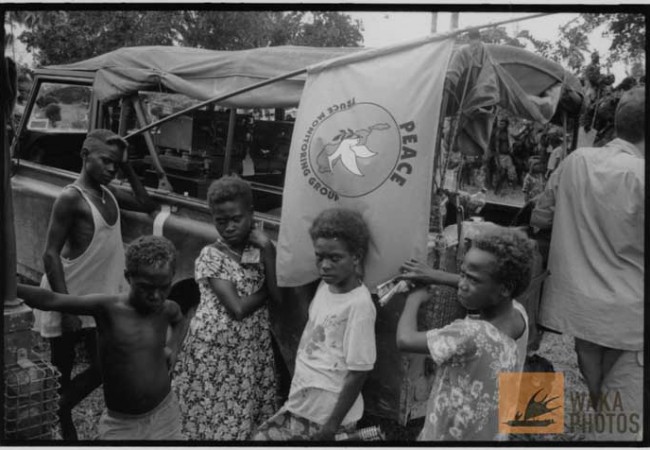
Grassroots security and grand chess moves
Last week the Asia Pacific Centre for Security Studies (APCSS) based in Honolulu partnered with us at PiPP to host a major workshop in Vanuatu on regional security architecture. Although “architecture” was the starting point, it was primarily an attempt to highlight ongoing conventional and non-conventional threats to regional security and explore the growing nexus between development and security.
The latter follows the notion that “you cannot have development without peace” – peace in all its manifestations – and reflects new approaches towards “human security” being built into the Sustainable Development Goals (SDGs), soon to replace the Millennium Development Goals (MDGs) in 2015.
The workshop brought together around 70 delegates from all over the Pacific, including defence, police, NGOs and government officials. Chatham House rules prevents me from directly quoting the participants, however some key themes emerged which are worth highlighting.
There was a broad consensus that the basic framework of regional security architecture was in place, that mechanisms such as the Biketawa Declaration were there to trigger regional responses to national problems if needed. Growing co-ordination by officials at the national, sub-regional (such as the MSG) and regional level (such as the PIF) suggest that the necessary linkages are there to deal with humanitarian and natural disasters as well as possible peacekeeping interventions in the event of conflict. However, while the regional mechanisms may be in place, problems remain at the national and local level to better manage cycles of payback violence, tribal war, resource exploitation and personal security issues such as stemming domestic violence.
A decade after the regional Peace Monitoring Group (PMG) oversaw Bougainville’s transition from war to peace, plus the RAMSI operation in the neighbouring Solomon Islands, lessons have been learnt about how to manage such interventions. RAMSI has its critics, particularly since it was not structured to actually deal with the “root causes” of the ethnic tension in the Solomons, however it did stabilize a situation that was spinning out of control and provided needed space to rebuild respect for governing institutions.
The peace process on Bougainville might be seen as the gold standard so far: a case of regional partners, led by Australia and New Zealand, providing unarmed troops to oversee a rapid demilitarization, using kastom reconciliation processes to maintain peace. It is the second point which has been key to its success. Rather than “imposing” peace like in many UN interventions, the unarmed PMG on Bougainville rightly saw that only through local ownership would the mission succeed, by creating the space necessary to allow chiefs and kastom leaders to use kastom reconciliation processes to flourish. This included many ceremonies that saw opposing militants symbolically break bows and arrows, chew beetlenut together and spit into holes which were then covered up; another symbolic gesture of burying their differences.
Traditional reconciliation processes often take years, even decades. Today, more than 15 years after the war ended, kastom reconciliation ceremonies in various communities are still taking place, underlining the need for national governments to maintain on-going peace-building measures. Many countries in our region have not invested enough in the idea of maintaining peace and internal cohesion – preventative measures -leading to perhaps too much crisis management when tensions do flare.
Approaches to regional peacekeeping and national peace-building are important if the Pacific is to better manage its periodic disasters – natural and man made. Both the MSG and others in the region are examining the possibility of creating a permanent regional peace keeping / disaster response force that can mobilized quickly. While the MSG force would be drawn only from the Melanesian nations, Australia and the PIF are also looking to establish a regional training center in the Pacific to allow for a wider variety of Pacific police and soldiers to be trained up to global standards and be able to participate in global UN peacekeeping operations.
Conventional threats and flashpoints were identified at the workshop – such as tension in the South China Sea and the ongoing conflict in West Papua, but many speakers were keen to highlight non-conventional threats to the Pacific, ranging from climate change impacts to the epidemic of obesity and non-communicable diseases (NCDs), to community policing and domestic violence concerns.
What was interesting to note is the growing acceptance in the security sector of civil society engagement and a more holistic approach to national security. Until recently, policy-making in the security area was the preserve of the uniformed services and government ministers. Now the MSG has an advisor to support national “wellbeing” indicators, the PIF has a conflict prevention advisor and a “human security framework” developed by civil society is being integrated into national security policy in places like Fiji.
This is not about doing warm and fuzzy, this is about ensuring governments at all levels are better equipped to deal with grassroots security concerns – particularly around resource exploitation, ethnic tension and domestic violence – as much as managing grand chess moves in regional geopolitics by the major powers.

